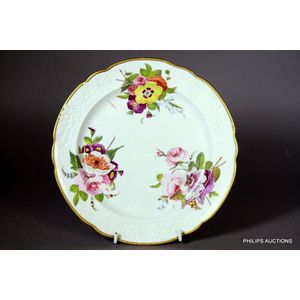Royal Worcester Sandwich Plate with Puce and Yellow Roses
You must be a subscriber, and be logged in to view price and dealer details.
Subscribe Now to view actual auction price for this item
When you subscribe, you have the option of setting the currency in which to display prices to $Au, $US, $NZ or Stg.
- Manner of .... / Style of ..... - A cataloguing term where the item, in the opinion of the cataloguer is a work in the style of the artist, craftsman or designer, possibly of a later period.
- Ivory - Ivory is a hard white material that comes from the tusks of elephants, mammoth, walrus and boar, or from the teeth of hippopotamus and whales. The ivory from the African elephant is the most prized source of ivory. Although the mammoth is extinct, tusks are still being unearthed in Russia and offered for sale.
Ivory has been used since the earliest times as a material for sculpture of small items, both in Europe and the east, principally China and Japan.
In Asia ivory has been carved for netsuke, seals, okimono, card cases, fan supports, animals and other figures and even as carved tusks.
In the last 200 years in Europe ivory has been used to carve figures, for elaborate tankards, snuff boxes, cane handles, embroidery and sewing accessories, in jewellery and as inlay on furniture. Its more practical uses include being used for billiard balls, buttons, and a veneers on the top of piano keys.
The use and trade of elephant ivory have become controversial because they have contributed to Due to the decline in elephant populations because of the trade in ivory, the Asian elephant was placed on Appendix One of the Convention on International Trade in Endangered Species (CITES), in 1975, and in January 1990, the African elephant was similarly listed. Under Appendix One, international trade in Asian or African elephant ivory between member countries is forbidden. Unlike trade in elephant tusks, trade in mammoth tusks is legal.
Since the invention of plastics, there have been many attempts to create an artificial ivory
This item has been included into following indexes:
- Hadley's Worcester (England) - ceramics 149
- Hadley, James - Royal Worcester artists 112
- Royal Worcester (England), item types
Visually similar items

A Royal Worcester display plate with hand painted rose decoration signed Kitty Blake and dated 1926. Diameter 13 cm

A rare and fine Charles Bourne floral plate, circa 1820, with painted mark in full for 1817-30 period, a finely lobed plate with a gilded border, three moulded floral sheaves to the rim and three loose polychrome bouquets of roses, passion flowers, anemone

A Chinese figural plate, delicately painted in bright famille rose enamels depicting female figures surrounded by auspicious Buddhist symbols, puce peonies, birds and butterflies, diameter 20 cm.

A Nantgarw floral plate, circa 1813-22, decoration in the style of Thomas Pardoe, with a gently scalloped rim decorated with three bouquets of summer blooms in colours upon a white ground; with impressed mark and also C W for china works. Provenance: with
